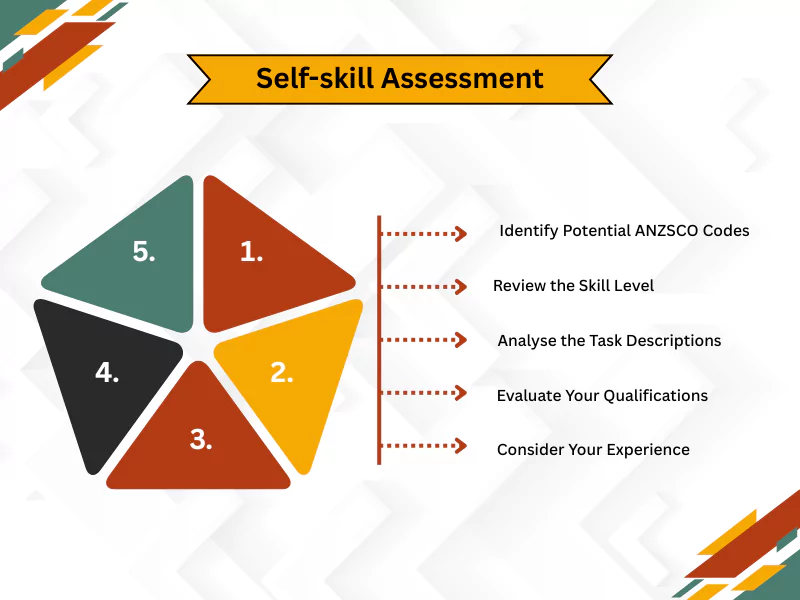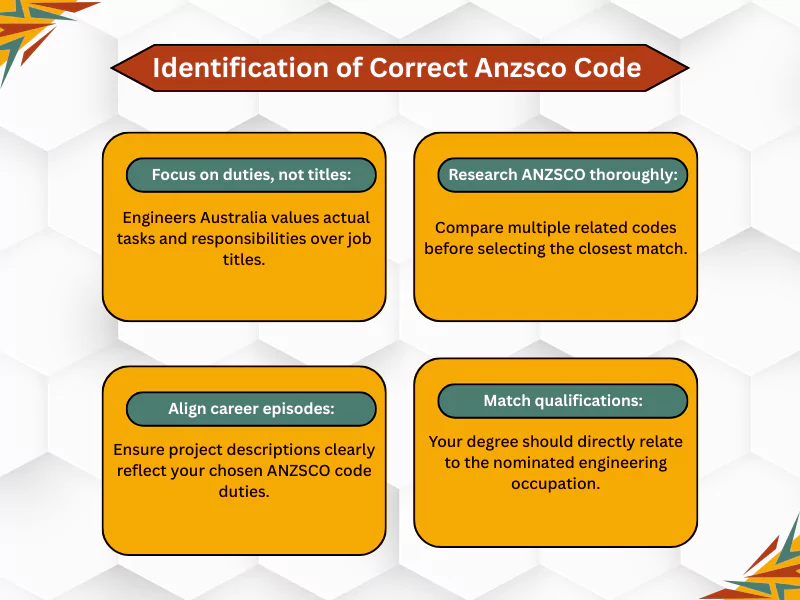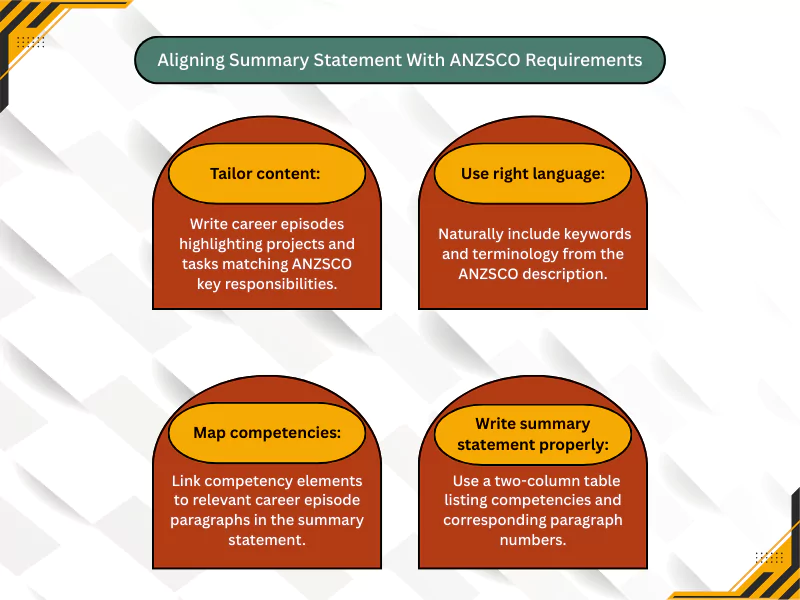For countless engineers worldwide, migrating to Australia represents a pinnacle career achievement. However, this journey is paved with meticulous documentation. Competency Demonstration Report (CDR) stands as the most crucial piece of evidence for your engineering capabilities.
Within this report, your Summary Statement acts as the critical link. This connects your documented experience to the specific skills required for your nominated profession. The key to a powerful and successful application lies in your ability to align Summary Statement with ANZSCO Codes.
This alignment is more than a procedural formality. It is the fundamental pillar of your skills assessment, and getting it right can be the difference between a swift approval and a frustrating rejection.
In this article, we will discuss everything about ANZSCO Codes and share practical guidance for proper skills alignment.
Table of Contents
ToggleWhat Is the ANZSCO Code?
The Australian and New Zealand Standard Classification of Occupations (ANZSCO) is a skills-based classification system. It categorises all occupations in the Australian and New Zealand labour markets.
Managed by the Australian Bureau of Statistics (ABS), it provides a standardised six-digit code for each occupation, detailing the expected skill level, qualifications, and the core tasks and duties involved.
This makes it easier for government agencies, employers, and educational institutions to match skilled workers with the right roles.
Why Is the ANZSCO Code Important for Engineers Australia (EA) Assessment?
For Engineers Australia (EA), ANZSCO Codes provide a clear framework to assess the competencies of an engineering applicant against the standards expected for that specific role in the Australian industry. To understand how it works, you need to grasp the significance of ANZSCO codes in CDR.
When you submit your CDR report to Engineers Australia, the ANZSCO code you select acts as the lens through which your entire application is viewed.
It sets the context for your skills and experience. EA assessors use this code to benchmark your qualifications, experience, and the competencies demonstrated in your Career Episodes as per the requirements of your nominated occupation.
What Skills and Responsibilities are Expected Under a Specific ANZSCO Code?
As already discussed, the ANZSCO code has a detailed description that outlines the key tasks, duties, and responsibilities associated with that occupation. All of the information can be found on the Australian Bureau of Statistics (ABS) website.
For example, the ANZSCO code for a Mechanical Engineer (233512) includes tasks such as:
- Planning and designing mechanical and thermal-hydraulic systems.
- Conducting research and advising on the design, development, and maintenance of machinery.
- Overseeing and monitoring the installation, commissioning, and operation of mechanical systems.
- Investigating and diagnosing faults and performance issues.
Note: Before selecting an ANZSCO code, it’s crucial to thoroughly review these descriptions and ensure that your own experience aligns with the listed responsibilities. But first, you need to understand which ANZSCO skill level you fall into.
What Is an ANZSCO Skill Level?
The ANZSCO framework classifies occupations into five skill levels. Here, Skill Level 1 is the highest. This skill level is not a measure of your personal abilities or intelligence. Rather, it is a formal classification of the level of skill that is typically required to perform the duties of a specific occupation competently.
Five skill levels are broken down as follows:

For professional engineers submitting a CDR to Engineers Australia, this concept is critical. The occupations you can nominate are almost exclusively at Skill Level 1. Therefore, your entire application must demonstrate that you possess the autonomy, knowledge, and problem-solving capabilities necessary to operate at this highest professional tier.
How Do You Assess Your Own Skill Level?

To assess your own skill level in the context of ANZSCO, you need to honestly and objectively compare your qualifications and experience to the requirements of your target occupation.
Here’s a step-by-step approach:
- Identify Potential ANZSCO Codes: Based on your engineering discipline and work experience, create a shortlist of potential ANZSCO codes.
- Review the Skill Level: For each code, check the ANZSCO Skill Level. As an engineer, you’ll likely be looking at Skill Level 1 occupations.
- Analyse the Task Descriptions: Carefully read the list of tasks and duties for each code. Do these descriptions accurately reflect your day-to-day responsibilities?
- Evaluate Your Qualifications: Does your engineering degree align with the educational requirements of the occupation?
- Consider Your Experience: Do you have the required amount of relevant work experience? For Skill Level 1, this is typically at least five years if you don’t have a formal qualification.
By going through this process, you’ll be able to determine which ANZSCO code is the best fit for your profile and whether your skill level meets the requirements of that occupation.
How Can You Identify the Correct ANZSCO Code for Your Engineering Occupation?

The process of selecting the correct ANZSCO occupation code is a crucial task that requires thorough research and self-assessment. Here’s a proper ANZSCO code guide for skilled migration:
- Focus on Your Duties, Not Your Job Title: Your job title might not accurately reflect the work you do. Engineers Australia is more interested in your actual tasks and responsibilities.
- Thoroughly Research the ANZSCO Database: Don’t just pick the first code that seems to fit. Take the time to read the descriptions of several related codes to find the one that is the closest match.
- Align with Your Career Episodes: The projects you describe in your career episodes should be a clear reflection of the duties listed in your chosen ANZSCO code. If there’s a mismatch, it will raise red flags for the assessor.
- Consider Your Qualifications: Your engineering degree should be relevant to the nominated occupation. For example, if you have a degree in electrical engineering, you should be applying for an electrical engineering-related ANZSCO code.
How Does the Summary Statement Relate to the Selected ANZSCO Code?
Your summary statement for Engineers Australia is the bridge between your career episodes and your nominated ANZSCO code. It’s a cross-referencing tool that demonstrates to the EA assessor that you have addressed all the required competency elements for your chosen occupation.
In your summary statement, you’ll need to link specific paragraphs from your career episodes to the competencies outlined in the MSA booklet for your nominated ANZSCO code. This EA summary statement and ANZSCO alignment provide the assessor with a clear and concise overview of your skills and experience, and how they align with the requirements of the occupation you are applying for.
How to Ensure Career Episodes & Summary Statement Meet ANZSCO Requirements?

Now that you have understood why making the correct ANZSCO code selection for Engineers Australia from the outset is vital for a smooth assessment process, to ensure your career episodes and summary statement are aligned with your chosen ANZSCO code, you need to:
Tailor Your Content
Write your career episodes with the ANZSCO description in mind. Highlight projects and tasks that directly relate to the key responsibilities of your nominated occupation.
Use the Right Language
Incorporate keywords and terminology from the ANZSCO description naturally into your career episodes. This shows that you understand the occupation and its requirements.
Map Your Competencies
In your summary statement, create a clear and accurate map that connects the competency elements to the relevant paragraphs in your career episodes. Make it as easy as possible for the assessor to see the connection.
Write Your Summary Statement Properly
For the summary statement itself, be methodical. Here are some summary statement writing tips:
- Create a simple two-column table.
- In one column, list the competency element.
- In the other, write down the exact paragraph number from your Career Episode(s) that provides the evidence.
This precision leaves no room for ambiguity.
What Happens If Your Summary Statement Doesn’t Align with the ANZSCO Code?

If your summary statement does not align with an ANZSCO code, it can result in several negative outcomes. First, you may be asked to provide additional information or clarification. This can result in significant delays to your migration plans. It may also require you to restart the entire CDR process from scratch.
But most specifically, a fundamental misalignment in Skill assessment with the correct ANZSCO code is often grounds for rejection. For example, if your career episodes describe work that doesn’t match the duties of your nominated ANZSCO Codes for Engineers, your application is likely to be rejected.
What Are the Common Mistakes Applicants Make When Linking Their Summary Statement with ANZSCO?
Apart from choosing wrong codes, there are other Mistakes in ANZSCO alignment for CDR people commit as well:
- Exaggerating or falsifying experience: Applicants may be tempted to embellish their career episodes to better match the ANZSCO description. This is a risky strategy, as assessors are experienced in spotting inconsistencies.
- Failing to provide enough detail: Your career episodes need to be detailed enough to clearly demonstrate your engineering skills and how they relate to your nominated occupation. Vague or generic descriptions are not sufficient.
- Incorrectly referencing paragraphs: A common error in the summary statement is referencing the wrong paragraphs from the career episodes. This makes it difficult for the assessor to follow your claims and can lead to a negative assessment.
To avoid mistakes, you can also consider taking Summary Statement Writing services for professional guidance.
Where Can You Find Professional Help for Aligning Your Summary Statement with ANZSCO Codes?
Given the high stakes involved, many engineers choose to seek professional assistance with their CDR, particularly with selecting the right ANZSCO code and aligning the summary statement.
TheCDRWriter is one of the reputable CDR writing services that specialises in helping engineers prepare their applications for Engineers Australia.
We have teams of experienced writers who are familiar with the EA guidelines and the nuances of the ANZSCO system.
If you are struggling with how to match a summary statement with ANZSCO and how to write a compelling summary statement for CDR, we can provide guidance in crafting compelling career episodes.
We can ensure your summary statement is perfectly aligned with your nominated occupation. Seeking professional help significantly increases your chances of a successful skills assessment and a smooth migration journey.
Conclusion
The alignment of your summary statement with your chosen ANZSCO code is not just a box-ticking exercise; it is the very foundation of your Competency Demonstration Report. By taking the time to carefully research and select the right ANZSCO code, and by meticulously crafting your career episodes and summary statement to reflect the duties and responsibilities of that code, you can significantly enhance your chances of a positive skills assessment and take a confident step towards your new life as an engineer in Australia.
Frequently Asked Questions
What Is the Purpose of the ANZSCO?
The ANZSCO serves different purposes:
- The primary purpose is to create a unified language for defining and describing occupations. This is essential for various governmental and industry functions.
- For Skilled Migration it allows the Department of Home Affairs to identify occupations in demand. This data helps authorities manage the intake of skilled workers to address specific labour market shortages. The Australian government regularly updates a Skilled Occupation List, and if your occupation is on this list, you may be eligible to apply for a skilled visa.
- Lastly, ANZSCO codes are instrumental in labour market analysis. It enables the government to monitor employment trends, identify skill shortages, and make informed policy decisions about workforce development.
What Is the Difference between Skills and Occupation?
In the context of ANZSCO, a skill is the ability to perform the tasks associated with an occupation competently. Skills are acquired through education, training, and experience. An occupation, on the other hand, is a set of jobs that require the performance of similar or identical sets of tasks.
How Does ANZSCO Measure Skill Levels for Specific Occupations?
ANZSCO measures skill levels based on the range and complexity of tasks involved, and is directly linked to the level of formal education, training, and relevant experience needed for the role. This assessment is based on a combination of factors, including:
- Formal Education and Training: The level and type of formal qualifications required, such as a bachelor’s degree, diploma, or certificate.
- Previous Experience: The amount of relevant work experience typically needed to perform the duties of the occupation.
- On-the-job Training: The extent of on-the-job training required to reach a competent level of performance.
- Complexity of Tasks: The range and complexity of the tasks involved in the occupation.
Meeting the benchmark means demonstrating that your experience is commensurate with the responsibilities expected of a degree-qualified professional in your field.
Is It Possible to Change the ANZSCO Code after Submitting the CDR to Engineers Australia?
It is possible to change your nominated ANZSCO code after you have submitted your application to Engineers Australia, but before it has been assessed. To do this, you will need to email Engineers Australia’s member services with your request. However, it is not possible to change your ANZSCO code after a positive skills assessment has been issued. If you wish to be assessed for a different occupation after a positive outcome, you will need to submit a new application. Therefore, it is crucial to get the ANZSCO code right the first time to avoid any unnecessary delays or complications.
Want To See My Profile — Click Here Iqbal
- How to Write a Summary Statement for Professional Engineer (Samples) - August 29, 2025
- Why Should You Align Summary Statement with ANZSCO Codes? - August 12, 2025
- How to Write a Summary Statement for an Engineering Associate? - July 30, 2025

